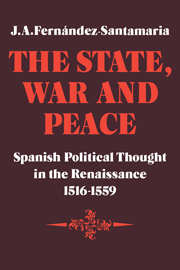Book contents
- Frontmatter
- Contents
- Abbreviations
- Acknowledgments
- Introduction
- PART I MEDIEVAL CONSTITUTIONALISM, CHRISTIAN HUMANISM, AND NEOSCHOLASTICISM (1516–1539)
- 1 The opposition to empire: Alonso de Castrillo
- 2 Advocates for empire
- 3 The discovery of America and the School of Salamanca: Francisco de Vitoria (I)
- 4 Francisco de Vitoria (II)
- 5 The age of Erasmus on war and peace
- Part II THE WANING OF ERASMIANISM (1539–1559)
- Bibliography
- Index
1 - The opposition to empire: Alonso de Castrillo
Published online by Cambridge University Press: 07 October 2011
- Frontmatter
- Contents
- Abbreviations
- Acknowledgments
- Introduction
- PART I MEDIEVAL CONSTITUTIONALISM, CHRISTIAN HUMANISM, AND NEOSCHOLASTICISM (1516–1539)
- 1 The opposition to empire: Alonso de Castrillo
- 2 Advocates for empire
- 3 The discovery of America and the School of Salamanca: Francisco de Vitoria (I)
- 4 Francisco de Vitoria (II)
- 5 The age of Erasmus on war and peace
- Part II THE WANING OF ERASMIANISM (1539–1559)
- Bibliography
- Index
Summary
The Habsburg succession
On November 26, 1504, Isabel of Castile died. For the next twenty years the Hispanic kingdoms in general and Castile in particular would live through severe internal storms which repeatedly threatened to tear asunder the delicate fabric of Spanish unity that the royal couple had wrought during more than thirty years of unceasing toil. At one moment it seemed as if Aragon and Castile would as of old go their own separate ways. At another it appeared that Castile might succeed in imposing upon her young sovereign the same kind of constitutional straitjacket which the Church in Council had once sought to force on the Pope.
The roots of Spain's twenty years of turmoil and the vicissitudes of her monarchy during the same period are sunk deep in the medieval soil; in those extraordinarily convoluted and vague principles which, more emotionally felt than rationally understood, often go under the name of medieval constitutionalism; the haphazard practices of a monarchical system which although strong on the surface could easily be brought to the point of crisis by the waning but still powerful forces to which the encroachments of central authority had brought lasting bitterness; and the uncertainties of the dynastic principle which through a succession of fateful demises brought the Trastámara inheritance into the hands of a foreign dynasty. If to these broad and remote antecedents we add the more immediate issues dominating Castilian and Burgundian politics between 1504 and 1516, the year of Ferdinand's death, the sordidness of the grim drama played out on the Castilian stage during the years preceding the revolt of her cities easily unfolds in all its stark nakedness.
- Type
- Chapter
- Information
- The State, War and PeaceSpanish Political Thought in the Renaissance 1516–1559, pp. 11 - 34Publisher: Cambridge University PressPrint publication year: 1977



